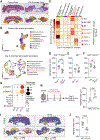Interleukin-17 governs hypoxic adaptation of injured epithelium
- PMID: 35709248
- PMCID: PMC9753231
- DOI: 10.1126/science.abg9302
Interleukin-17 governs hypoxic adaptation of injured epithelium
Abstract
Mammalian cells autonomously activate hypoxia-inducible transcription factors (HIFs) to ensure survival in low-oxygen environments. We report here that injury-induced hypoxia is insufficient to trigger HIF1α in damaged epithelium. Instead, multimodal single-cell and spatial transcriptomics analyses and functional studies reveal that retinoic acid-related orphan receptor γt+ (RORγt+) γδ T cell-derived interleukin-17A (IL-17A) is necessary and sufficient to activate HIF1α. Protein kinase B (AKT) and extracellular signal-regulated kinase 1/2 (ERK1/2) signaling proximal of IL-17 receptor C (IL-17RC) activates mammalian target of rapamycin (mTOR) and consequently HIF1α. The IL-17A-HIF1α axis drives glycolysis in wound front epithelia. Epithelial-specific loss of IL-17RC, HIF1α, or blockade of glycolysis derails repair. Our findings underscore the coupling of inflammatory, metabolic, and migratory programs to expedite epithelial healing and illuminate the immune cell-derived inputs in cellular adaptation to hypoxic stress during repair.
Figures






Comment in
-
IL-17A-HIF1α axis in epithelial wound repair.Nat Rev Immunol. 2022 Sep;22(9):532-533. doi: 10.1038/s41577-022-00768-3. Nat Rev Immunol. 2022. PMID: 35859035 No abstract available.
-
IL-17 signaling in skin repair: safeguarding metabolic adaptation of wound epithelial cells.Signal Transduct Target Ther. 2022 Oct 8;7(1):359. doi: 10.1038/s41392-022-01202-9. Signal Transduct Target Ther. 2022. PMID: 36209253 Free PMC article. No abstract available.
-
Cutting edge: interleukin-17a prompts HIF1α for wound healing.Trends Immunol. 2022 Nov;43(11):861-863. doi: 10.1016/j.it.2022.09.013. Epub 2022 Oct 7. Trends Immunol. 2022. PMID: 36216717
References
MeSH terms
Substances
Grants and funding
LinkOut - more resources
Full Text Sources
Other Literature Sources
Molecular Biology Databases
Miscellaneous

